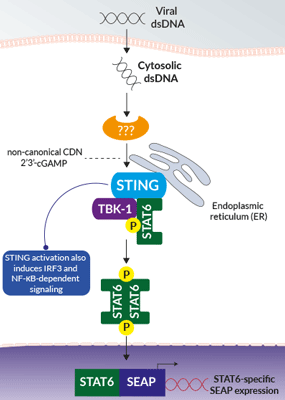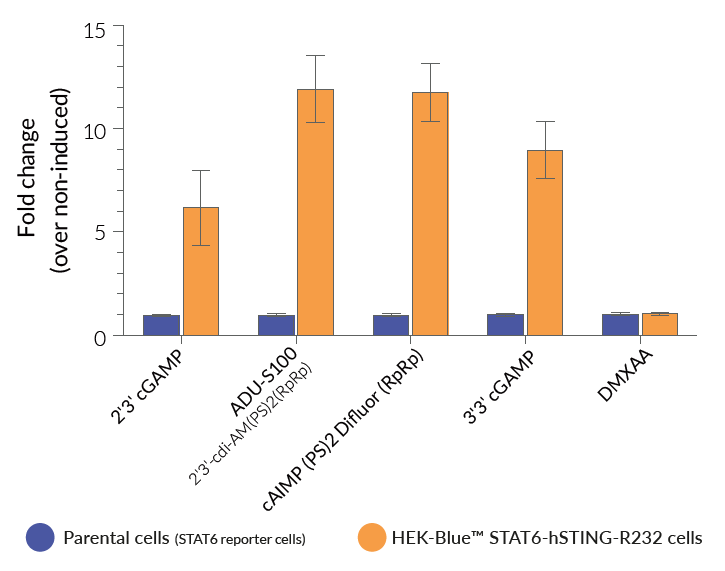Human STING (R232)-dependent STAT6 reporter cells
| Product | Unit size | Cat. code | Docs. | Qty. | Price | |
|---|---|---|---|---|---|---|
|
HEK-Blue™ STAT6-hSTING-R232 Cells Human STING (R232 variant)-dependent STAT6 HEK293 reporter cells |
Show product |
3-7 x 10e6 cells |
hkb-st6r232
|
|
||
|
HEK-Blue™ STAT6-hSTING-R232 vial Additional cell vial |
Show product |
3-7 x 10e6 cells |
hkb-st6r232-av
|
Notification: Reference #hkb-st6r232-av can only be ordered together with reference #hkb-st6r232.

STING-dependent STAT6 activation
in HEK-Blue™ STAT6-hSTING-R232 cells
Human STING-dependent STAT6 reporter HEK293 cells
HEK-Blue™ STAT6-hSTING-R232 cells are specifically designed to monitor the induction of STAT6-dependent signaling upon activation of STING. These cells were generated by stable overexpression of the most prevalent human (h)STING variant R232 [1], in a human embryonic kidney (HEK)293-derived cell line that expresses human STAT6 and a STAT6-inducible secreted embryonic alkaline phosphatase (SEAP) reporter. STAT6-dependent SEAP activity is readily assessable in the supernatant using QUANTI-Blue™ Solution, a detection reagent.
STING Background
STING (stimulator of interferon genes) is essential in the effective immune response against foreign or self-DNA through the sensing of cytoplasmic cyclic dinucleotides (CDNs) [2]. The activation of STING causes a TANK-binding-kinase-I (TBK1)-dependent cascade, ultimately, leading to IFN regulatory factor (IRF3)-dependent type I IFN production and NF-κB-dependent inflammatory cytokine production [2]. Additionally, signal transducer and activator of transcription 6 (STAT6) has been reported to be recruited to STING for TBK1-mediated phosphorylation during viral infection [3]. Ultimately, the STING‑dependent activation of STAT6 induces a specific set of anti-viral chemokines responsible for immune cell homing, which leads to reduced viral replication [3]. Notably, this specific 'viral' activation of STAT6 was found to be Janus kinase (JAK)-independent and is thus, distinct from the ‘canonical’ STAT6 pathway activated by IL-4 and IL-13, which is critical in adaptive immunity [3].
Features of HEK-Blue™ STAT6-hSTING-R232 cells:
- Verified overexpression of hSTING (PCR and functional assays)
- Functionally validated with a selection of STING ligands
- These cells do not respond to Type I IFNs
- Readily assessable STAT6-dependent SEAP reporter activity
- The stability for 20 passages has been verified
- Guaranteed mycoplasma-free
Applications for HEK-Blue™ STAT6-hSTING-R232 cells:
- Studying the role of STING-dependent STAT6 activation in response to viral infection
References:
1. Yi, G. et al. 2013. Single nucleotide polymorphisms of human STING can affect innate immune response to cyclic dinucleotides. PLoS One 8, e77846.
2. Cheng, Z. et al. 2020. The interactions between cGAS-STING pathway and pathogens. Signal Transduct Target Ther 5, 91.
3. Chen, H. et al. 2011. Activation of STAT6 by STING is critical for antiviral innate immunity. Cell 147, 436-446.
Specifications
Antibiotic resistance: Blasticidin, Hygromycin B, and Zeocin®
Growth medium: DMEM, 4.5 g/l glucose, 2 mM L-glutamine,10% (v/v) heat-inactivated fetal bovine serum (FBS), Pen‑Strep (100 U/ml-100 μg/ml), 100 μg/ml Normocin™
Quality Control:
- STAT6-dependent SEAP reporter activity in response to various STING ligands and other cytokines has been validated.
- The stability for 20 passages, following thawing, has been verified.
- These cells are guaranteed mycoplasma-free.
Contents
- 3-7 x 106 HEK-Blue™ STAT6-hSTING-R232 cells in a cryovial or shipping flask
- 2 x 1 ml of HEK-Blue™ Selection (250x concentrate)
- 1 ml of Normocin™ (50 mg/ml). Normocin™ is a formulation of three antibiotics active against mycoplasmas, bacteria, and fungi.
- 1 ml of QB reagent and 1 ml of QB buffer (sufficient to prepare 100 ml of QUANTI-Blue™ Solution, a SEAP detection reagent)
![]() Shipped on dry ice (Europe, USA, Canada and some areas in Asia)
Shipped on dry ice (Europe, USA, Canada and some areas in Asia)






